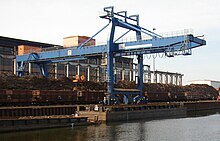Lighter (ship type)
A lighter , even lights , Light Ship , lights ship , Bording , Prähm , barge or Hamburg barge is originally a watercraft, which serves larger vessels because of their draft, can not start right landing points to "lights" so its charge to take over in whole or in part. It can also be used to transport goods to these ships when they are in the roadstead . Mostly they are flat-bottomed, simple vessels with a low draft, with or without their own drive. As a special form, lighterserve as buoyancy for larger ships to enable them to overcome shallows . The Amsterdam camels are particularly worth mentioning here.
In recent times, lighters are mostly non-propulsion, floating cargo containers that are moved, for example, in push convoy or towing .
general description
The lighter is an unmanned vehicle and has no real drive of its own . Part of the barges that are used in convoys have today -headed . These serve to improve the maneuverability of the push convoys, for example in empty descent in strong winds. The head rudder is controlled from the push boat. The barges are equipped with anchor winches and coupling winches. Push barges that are used in coupling formations almost always have a multi-channel bow thruster system . With their help, they can make small changes of location in ports and when leaving locks on their own. Lighter , which are always part of a coupling convoy, have, in contrast to pushed barges in pushed convoys, a pointed bow and very often also a flat in the bow area. In addition to the anchor and coupling winches , these barges often have a ballast system with which the draft can be adapted to that of the pushing ship.
The most frequently used lighter is the Europa-lighter type IIa with a length of 76.50 m, a width of 11.40 m and a loading capacity of 2,850 tons. There are also larger and smaller barges, the dimensions of which have often been adapted to the particular waterway conditions in some shipping areas. Another type of barge are the LASH barges, which are transported by seagoing vessels and reach their destination on inland waterways in combination with pushed convoys.
LASH lighter
LASH lighters are buoyant transport containers that are transported across the sea by LASH carriers. They have a size of 18.75 x 9.50 m and a load capacity of 370 tons. These barges are either floated out in the seaport or launched into the water using on-board crane systems. For further transport into the hinterland which are lighter combined to pushed convoys and pushed by a push boat. Since the lighter without anchor Tableware and also have no bug head barges are coupled to the tip of the dressing.
Soul light
Soul lighters , also called pontoon or barge , are used, similar to lighters in inland shipping, for a variety of purposes in overseas transport, depending on their design. In contrast to inland shipping, they are, except in exceptional cases, carried across the sea. They are adapted in size and design to the tougher loads of their area of application and, in addition to mooring facilities, usually also have emergency towing equipment and anchor gear. Special constructions such as heavy cargo barges are also partly equipped with structures for accommodation, auxiliary machines and pump systems for diving the barge.
The Hong Kong Derrick Barge is a special form and is only used in this form in Hong Kong.
See also
- Ship without its own propulsion
- Jack-up platform , also known as jack-up barge
literature
- Holger Patzer: The river and port shipping of the DDG Hansa . HM Hauschild, Bremen 2009, ISBN 3-89757-140-4 .
- Arnold Kludas , Harry Braun: Ewerführer . An illustrated history of the Ewerführer on Hamburg's waterways. 2nd Edition. The Hanse - Sabine Groenewald Verlage, Hamburg 2002, ISBN 3-434-52602-1 .
Individual evidence
- ↑ Brockhaus' Kleines Konversations-Lexikon, fifth edition, volume 2. Leipzig 1911., p. 660.
- ↑ Brockhaus' Kleines Konversations-Lexikon, fifth edition, volume 2. Leipzig 1911., p. 38.
- ^ Lueger, Otto: Lexicon of the entire technology and its auxiliary sciences, Vol. 6 Stuttgart, Leipzig 1908., P. 127.
- ↑ Brockhaus Conversations-Lexikon Vol. 7. Amsterdam 1809, p. 562.
- ↑ Adelung, Grammatical-Critical Dictionary of High German Dialect, Volume 2. Leipzig 1796, p. 2053.



